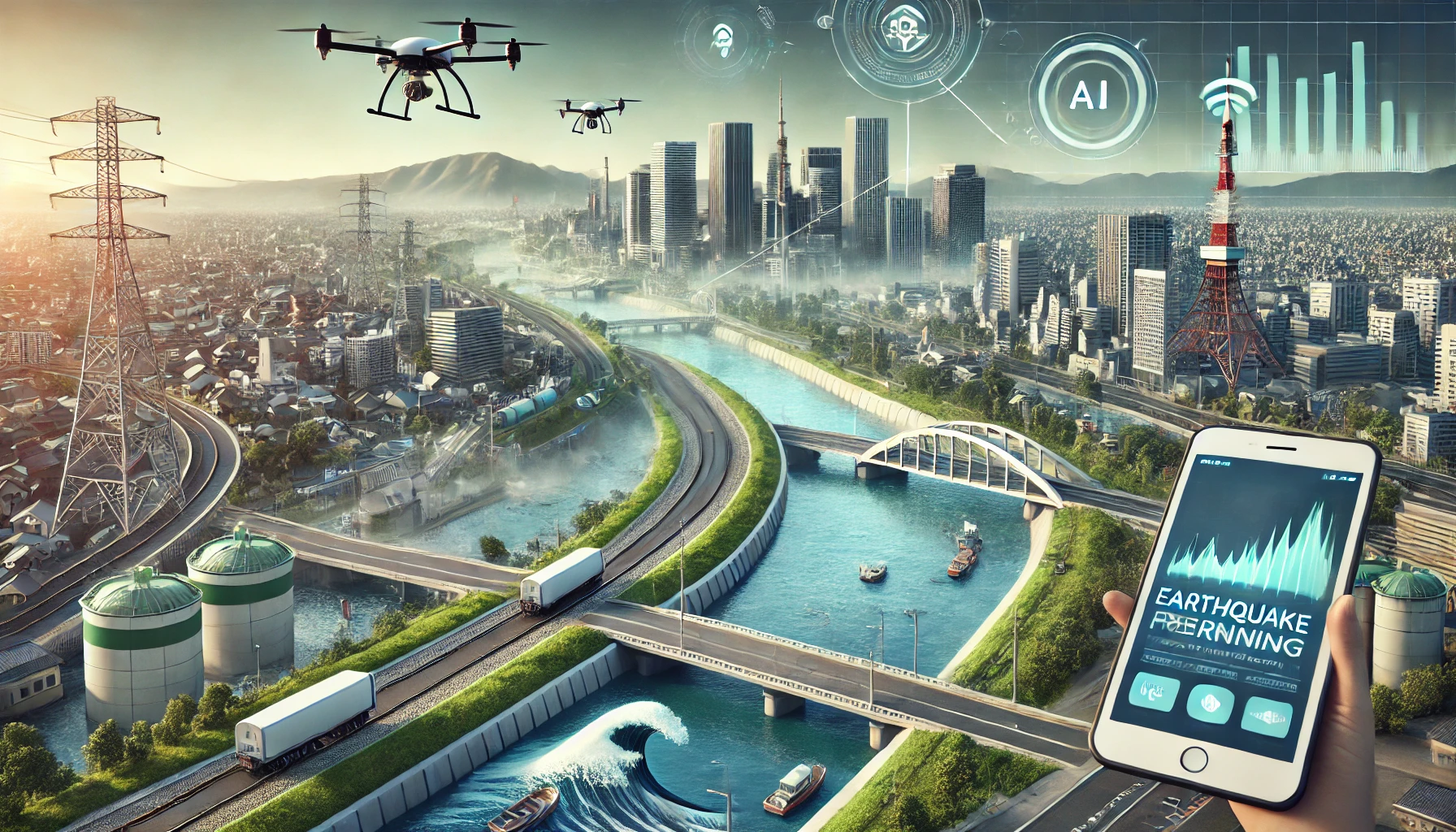Japan Disaster Prevention Technology: Early Warning and Communication Systems Help Save Lives During Natural Disasters
Japan Disaster Prevention Technology: Japan is no stranger to natural disasters, having experienced devastating earthquakes, tsunamis, and typhoons over the years. With its vulnerability to such disasters, the country has become a global leader in disaster prevention technology, constantly developing new ways to mitigate damage and save lives.
This blog will explore how Japan’s earthquake early warning systems, tsunami warning systems, and AI disaster management technologies work together to protect the population. We will also look at Japan’s drone disaster response systems and how the country’s earthquake-resistant buildings and flood prevention technology contribute to a robust, proactive disaster management strategy.
Japan Earthquake Early Warning System: A Critical Lifeline
Japan is one of the most seismically active countries in the world, making its earthquake early warning system one of the most vital tools for disaster preparedness. Since earthquakes can strike at any time, Japan’s system provides residents with a few seconds to prepare before the shaking begins, which can be life-saving.
How the System Works
The Japan earthquake early warning system uses seismic sensors scattered throughout the country. When these sensors detect the first signs of seismic activity, known as P-waves (the initial, less destructive waves), the system immediately sends out alerts via smartphones, TV broadcasts, and loudspeakers. This warning can give people anywhere from 5 to 60 seconds to prepare by stopping vehicles, turning off gas, or seeking shelter.
The success of the early warning system lies in its speed. The system relies on real-time data to predict the intensity of shaking in different areas, and though the warning time is brief, it is often enough to prevent serious injuries and fatalities.
Tsunami Warning System in Japan: Guarding Coastal Areas
In addition to earthquakes, Japan faces a constant threat of tsunamis. The tsunami warning system in Japan has been developed to protect vulnerable coastal areas, offering critical evacuation time to those at risk.
Tsunami Detection and Alerts
Japan’s tsunami warning system relies on a network of undersea pressure sensors and coastal tide gauges. These sensors detect changes in water pressure caused by seismic activity beneath the ocean. Once a potential tsunami is detected, warnings are issued to coastal areas through sirens, loudspeakers, and media broadcasts.
One of the most significant improvements in recent years is the ability to issue highly localized warnings. These systems pinpoint which areas will be most affected and provide specific evacuation routes for those in danger, ensuring an efficient and orderly response.
AI Disaster Management in Japan: Harnessing the Power of Technology
Japan’s disaster preparedness isn’t limited to early warning systems; the country has also embraced AI disaster management technology to anticipate and respond to crises more effectively. AI allows for faster decision-making and more accurate predictions during disasters.
Predictive Models and Resource Allocation
By utilizing AI disaster management systems, Japan can predict the impact of earthquakes and tsunamis with greater accuracy. AI models analyze historical data and real-time information to forecast the extent of damage, helping authorities allocate resources and dispatch emergency responders efficiently. This predictive capability is critical in urban areas where rapid, coordinated responses can save lives.
Drone Disaster Response in Japan: Fast and Efficient Relief
Japan has also integrated drone technology into its disaster response framework. Drone disaster response systems play an essential role in assessing damage, delivering supplies, and monitoring areas that are difficult to access.
The Advantages of Drones in Disaster Scenarios
Drones can be deployed immediately after a disaster to capture aerial images of affected areas. This information is then used to assess the extent of the damage and identify areas in need of urgent assistance. In the case of a tsunami or earthquake, drones can locate survivors, identify blocked roads, and even deliver medical supplies to remote locations.
Japan’s use of drone disaster response technology represents a significant advancement in post-disaster operations. It reduces the risk to human responders and speeds up relief efforts, making it easier to prevent secondary disasters like fires or floods.
Earthquake-Resistant Buildings in Japan: Building Resilience
A key element of Japan’s disaster prevention technology is its focus on earthquake-resistant buildings. Due to frequent seismic activity, Japan has developed some of the most advanced construction techniques in the world to ensure that buildings can withstand powerful earthquakes.
The Science Behind Earthquake-Resistant Structures
Modern Japanese buildings are designed with flexibility in mind. Earthquake-resistant buildings incorporate shock absorbers, dampers, and flexible foundations that can move with the shaking, reducing the likelihood of structural failure. In addition, high-rise buildings often include tuned mass dampers, which act as counterweights to reduce swaying during an earthquake.
These innovations have helped Japan minimize damage during earthquakes. While no structure is entirely earthquake-proof, Japan’s earthquake-resistant buildings are far more resilient than traditional structures, significantly lowering the risk of collapse during large tremors.
Smart Cities and Disaster Prevention in Japan
In recent years, Japan has embraced the concept of smart cities to further enhance disaster prevention. Smart cities integrate technology, data analytics, and communication systems to improve urban resilience in the face of natural disasters.
How Smart Cities Are Built for Disaster Preparedness
One example of smart city disaster prevention is the use of real-time data to monitor weather patterns, seismic activity, and flood levels. Smart cities also employ AI-powered infrastructure that can adjust in real time to potential disasters, such as automatically closing floodgates when water levels rise.
Moreover, smart city disaster prevention includes improving communication systems. Japan’s disaster communication systems in these smart cities use IoT sensors to send real-time updates to residents, ensuring that they are informed about evacuations, road closures, or other critical information during emergencies.
Japan’s Flood Prevention Technology: Mitigating Water Damage
Japan is also a leader in flood prevention technology, which is crucial given the country’s susceptibility to heavy rains and typhoons. Flooding is a common problem during Japan’s rainy season, and flood prevention technology plays a key role in mitigating damage.
Innovative Solutions for Flood Control
Japan’s flood prevention technology includes the use of underground reservoirs, floodgates, and levees to divert water away from populated areas. Tokyo’s massive underground stormwater system, known as the “G-Cans Project,” is one of the largest and most advanced flood control systems in the world. It can store millions of gallons of water, protecting the city from severe flooding.
How Japan’s Disaster Prevention Technology Saves Lives
Japan’s commitment to disaster prevention technology has saved countless lives and continues to evolve as new technologies emerge. From the earthquake early warning system to tsunami warning systems and AI disaster management, Japan has set a global example in disaster preparedness.
The integration of drone disaster response systems, earthquake-resistant buildings, and flood prevention technology ensures that the country is ready to face any natural disaster with resilience. By embracing these technologies and constantly innovating, Japan proves that proactive disaster management is the key to minimizing loss of life and damage.
To learn more about how technology is shaping disaster prevention strategies around the world, check out the resources available at Regent Studies.
For additional insights on disaster technology and prevention, explore this comprehensive report on disaster preparedness in Japan.




